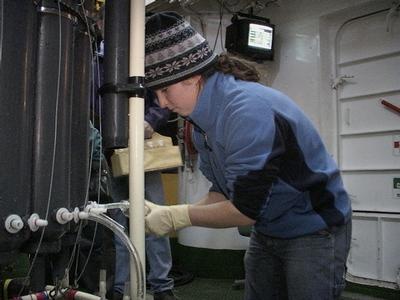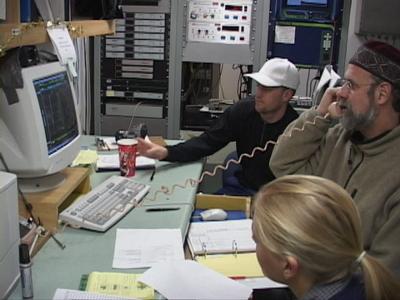
|
|
9 February, 2001
CTD - Conductivity, Temperature, Depth
The CTD is a very elaborate water collection device that has the potential
to sample sea water at 24 different depths. The CTD is also the first
experiment we conduct when we arrive at a station (Why would we collect
water before sediment? *). As we send the CTD to the bottom of the ocean,
information is being sent back to us constantly. For example, the
temperature of the water is measured 24 times a second, which with the CTD
traveling at a speed of 30 to 50 meters a minute means a reading every 2
cm! What is so important about water temperature? The water here in
Antarctica is the coldest and saltiest anywhere in the world. If cold
surface water is denser than the water below what does it do ? Right!
Sink! The same is true for salt water, and as such the water from here is
where most of the world's ocean bottom water comes from. You might not
know this, but water has structure; just as there is specific architecture
in buildings, so it is with water. When we talk of the "water column" we
are talking of its architecture. Its architecture is defined mostly by
mass, density, and composition. Temperature and salinity alone can
actually make a fingerprint of sorts. Water can only change its
temperature and salinity at the surface. Once the water sinks it cannot
change anymore, so a fingerprint of the water is made. Over time, as the
water slowly travels the ocean floor it maintains its fingerprint so that
one day, 500 to a 1000 later years, perchance, someone may take a sample
off the coast of California and they could actually trace the water back
by its fingerprint, to the approximate time it first sank here in
Antarctica. Several scientists on board are using the water samples for
several different things. I am looking at the diatoms in the surface
water, as well as at its photosynthetic maximum, which can be up to tens
of meters below the surface. Others are interested in the temperature of
the water at the bottom. Dr Dunbar is testing so many things that I will
have to save his work for another journal entry.
(The reason for doing the CTD first is so that we don't have any sediment
mixing with the water and changing our sample)



Contact the TEA in the field at
.
If you cannot connect through your browser, copy the
TEA's e-mail address in the "To:" line of
your favorite e-mail package.
|
